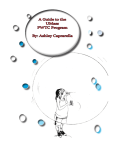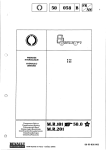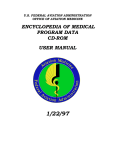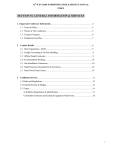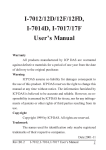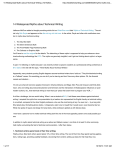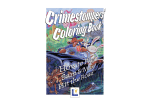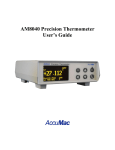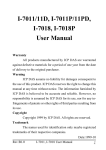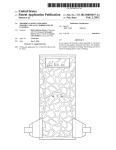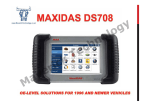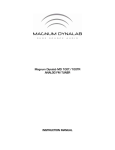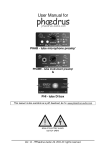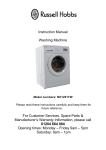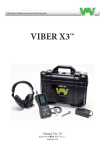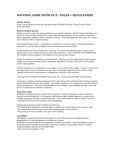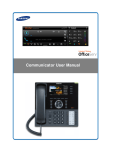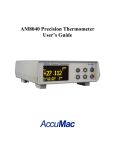Download A Handbook for PWTC Students
Transcript
Droogs 101
A Handbook
for PWTC Students
Edited and Designed By: Melissa Karlen
Droogs 101:
A Handbook for
PWTC Students
Contributing Authors:
Victoria Willis, Riké Franklin, Peter Arsenault, Kevin
O’Connell, Ashley Caprarella, Ashley McShea, Anna
Hatton, Sadie Trombetta, Robin Garabedian, Karina
Laurenitis, Shevonne Commock, Devon Magoon,
Allison Rocheleau, Lisa Donaghue, Daniel Ronan,
Ismail Eddafali, Emma Pampanin, Alex Foley, and
Kirstyn Costa.
Introduction
Fellow Droogs,
The PWTC class of 2012 leaves behind our tips and advice for surviving the Professional and Technical Writing
Certificate Program. We hope that you read this handbook
carefully--whether it be frontwards, backwards or out of
order.
If you ever feel lost and overwhelmed, which may be more
often than not, just take a deep breath, rest your eyes and
return when you’re ready.
Inspiration seems to always happen well after midnight.
Edited and Designed By: Melissa Karlen
© 2012
3
Table of Contents
Introduction 3
Chapter 1: Welcome Fellow Droogs
1.1 What is Technical Writing?
1.2. PWTC Course Overview
1.3. PWTC Software
1.4. PWTC Alumni
6
7
8
9
Chapter 2: Tips for Writing
2.2 How to Write an Introduction 11
2.3. Tips for Managing Tone 12
2.3. How to Write a Callout 13
2.4. Writing Modular Documentation 14
2.5. Writing Cover Memos 15
2.6. Concision Tips 16
2.7. User Testing 17
Chapter 1:
We l c o m e F e l l o w
D ro o g s
Chapter 3: Tips for Visual Design
3.1. What the Font 19
3.2. Alignment and Heiarchy 20
3.3. Caling All Colors
21-22
3.4. White Space 23
3.5. Creating Callouts 24
Chapter 4: Finishing Up
4.1. Last-Minute Checklist 26
4.2. Covers and Front Matter 27
4.3. Combining PDF Pages 28
4.4 Printing and Print Shops 29-30
4.5. How to Dual Boot
31-33
4
5
What are Professional Writing
and Technical Communication?
As English majors, students often study the works of many famous authors—striving to understand
the world they lived in. These authors write in ink, on paper, published in books, about politics,
philosophy, movements and society. But our world is very different than the world those dead
authors came from….
We live in a digital world, surrounded by technology. We type on screens and talk about apps,
browsers and software. We scan websites not just reading text but listening to podcasts and watching YouTube videos. Professional writing and technical communication is an English major’s adaptation to the 21st century—opening up opportunities beyond writing novels and poetry.
P ro fe s s i o n a l W r i t i n g
Examples of Professional Writing Genres
• Grant Proposals
• Software Documentation
• Journal Articles
• Website Authoring
• Reviews
Professional writing uses clear language to
convey information in a way that is easily
understood by an intended audience
T e ch n i c a l C o m m u n i c a t i o n
Technical communication provides information
or instructions for how to use and understand
specific technologies. By presenting technical
information in an appropriate way, information
can be more accessible--making someone’s life
easier and more productive.
P W T C a t U M a s s A m h e rs t
PWTC at UMass Amherst offers students an opportunity to learn about different kinds of software as well as teach and help others through
their completed grant proposals, user documentation and personal portfolio websites.
Students challenge their technical skills as well
as their writing—constantly learning and pushing their abilities in this digital world.
6
Modes of Technical Communication
• Web Pages
• Help Files
• Social Media Sites
• Software Instructions
• User Documentation
Jobs within Technical Communication
• Technical Writers & Editors
• Information Architects
• Instructional Designers
• Technical Illustrators
• Globalization & Localization Specialists
• Usability & Human Factors Professionals
• Web Designers & Developers
Overview of PWTC Courses
All courses are 3 credits. English 379 and English 380 are offered in the fall semesters while English 381, English 382, and English 391c are offered in the spring semesters. Students must be a
junior or senior and maintain a 3.0 GPA to be enrolled in the PWTC program.
Eng 379: Introduction to Professional Writing
This class teaches you the basics of Professional Writing. It focuses
on technicalities of writing like style and grammar as well as résumé
building. Prerequisite is English 112 (or equivalent).
Software used: MS PowerPoint W.E.B. Dubois Library Databases
Major Projects:
Research Paper
Group Presentation
Mock Grant Proposal
Eng 380: Intermediate Technical Writing
This class focuses on Technical Writing, specifically modular documentation. The production of the final project is a semester long
process including planning, writing, editing, user-testing, and professional printing and binding. English 379 must be taken prior to or
during the same as English 380.
Software used: InDesign, Adobe Robohelp, Adobe Framemaker
Major Projects:
30-35 Page Word Manual
Group Demo
English 381: Advanced Technical Writing I
This course builds upon the skills learned in English 380 in order
to improve students’ level of organization as well as written and
graphical talent. The specific software covered is currently used in
fields students may enter upon graduation. English 380 must be
taken prior to taking this course.
Software used: InDesign, Adobe Robohelp, Adobe Framemaker
Major Projects:
Collaborative Handbook
Group Demos
English 382: Advanced Technical Writing II
This class functions as the “capstone” course for the PWTC program, and is therefore geared towards seniors. This course gives
students a chance to choose a specific area they may want to
specialize in. There will be mock interviews, alumni visits, portfolio workshops and more. English 381 must be taken prior to or
simultaneously with this course.
Major Projects:
Independent Project of
Student’s Choice
English 391C: Advanced Software for Professional Writers
Focusing specifically on print and web design, this class is the most
software-heavy of all five. All of the work completed for this course
is showcased in an online portfolio each student creates for his or
herself. Upon completion of this course, students will be fluent in
use of HTML.
Software used: Adobe Dreamweaver, Adobe Flash, Adobe
Photoshop, MS Powerpoint
7
Major Projects:
Online Portfolio
Proto-site
Professional Writing and
Technical Communication Alumni
PWTC Software
The PWTC program has a strong focus in pairing analytic writing with new technologies. As
a PWTC student, you will gain experience in specialized documentation and editing software by drafting original content on digital platforms. Here is an alphabetical list of software
used throughout the PWTC program:
Adobe Dreamweaver is a web authoring and editing program that provides visual
and code-level capabilities for creating standards-compliant XML and HTML websites
and designs. You will use this program to build numerous websites in English 391.
Adobe Flash is a creative environment for producing expressive interactive content.
You will be introduced to Flash and its built-in programming language called ActionScript 3.0 for coding your own animations and games in English 391.
Adobe FrameMaker is a powerful authoring, managing, and publishing solution for
use in consistent creation of template-based technical documents. You will tame your
own massive writing projects with FrameMaker in English 381.
Adobe InDesign is a design package used in proofing page layouts before their print
or digital distribution. The creative tools in InDesign provide precise control over typography and consistency. You will become familiar with this powerful production tool in
English 381.
Adobe Photoshop is the industry-standard digital imaging program. This program
includes tools for photography editing and realistic painting. You will design both
task-based and free-form PhotoShop projects in English 391.
Adobe RoboHelp is a software solution that creates and organizes help systems,
policies, and procedures in an industry-standard format. You will use RoboHelp to create an online help system for a process or procedure of your choosing in English 381.
Microsoft PowerPoint is the leading presentation software for use in illustrative and
informative projects. Designed for use in front of an audience, you will use PowerPoint
to give presentations on controversial and intriuging topics in both English 379 & English 391.
Microsoft Word is the definitive word processor. Between formatting tips, command
shortcuts, and practical demonstrations, you will become intimately familiar with
Word’s capabilities as you write a software manual on the program in English 380.
8
Graduates of the University of Massachusetts Amherst Professional Writing and Technical Communication program have been employed by companies such as Alacatel-Lucent, Hewlett-Packard,
IBM Lotus Software, Motorola, Outcome Sciences, RSA Security, Misys Healthcare, Eze Castle
Software and Oracle Corporation. Some alumni have gone into the medical field while others
continue to work with software. One was offered a job as a technical writer, but ended for a travel
agency in Italy. PWTC alumni have also become documentation managers, technical writers, book
and journal editors, and trainers. Some of the daily tasks technical writers do include contacting
other coworkers to develop different projects, and using the skills learned in the PWTC courses to
write/email effective instructions.
ALUMNI
Kelsey Anderson: graduated in 2011,
User Experience Copywriter at Athena
Health.
Michael Fonseca: graduated in 2010
Associate Technical Project Consultant at
Outcome Science.
Gwendolyn Gustavson: graduated in
2011
Senior Paralegal at Bergmann & Moore.
Corry Mackin: graduated in 2009
Associate Technical Writer at Oracle.
Gabrielle Segalla: graduated in 2010
Junior Technical Writer at Axeda Corporation
Megan Strathearn: graduated in 2010
Web Design/ Developer at the College
of Humanities and Fine ArtsInformation
Technology department at UMass Amherst Research Assistant for 4MALITY
(web-based tutoring system, within the
School of Education).
Wher
e Are
They
Now
?
Average Salaries
Technical Writer: $32,000 to $84,000
Technical Editor: $36,000 to $57,000
Senior Technical Writer: $56,000 to $81,000.
Overall, it depends on the company you are
working for, your position, skills, and
years of experience.
The average pay for some technical writing positions
can be found at payscale.com and poewar.com
9
H o w t o Wr i t e a n I n t ro d u c t i o n
ion?
ressively
What is an Introdlf uwict
on to a module, it prog
th writing an introducti
se
ur user is.
After familiarizing your
ying attention to who yo
pa
e
ar
u
yo
as
ng
lo
as
s
is
es
r included. This section
becomes a simple proc
ve
ne
e
ar
s
on
cti
re
di
d
s
htforward an
e directions. The user ha
The introduction is straig
th
r
fo
e
ar
ep
pr
to
er
us
d enables the
ducclear-cut, organized, an
explaining so the intro
e
ar
u
yo
at
th
e
ul
od
m
ledge of the
some background know
cy.
order to avoid redundan
in
ief
br
pt
ke
s
ay
alw
is
tion
Chapter 2:
Ti p s f o r Wr i t i n g
Why Write an Introduction?
The overall importance of an introduction is to state the task that is
going to be explained in the following set of directions. Mainly, the
introduction clarifies any information that can be viewed in the directions. The user can gain a better understanding of basic concepts and
can determine if the following set of directions will be beneficial.
What should be in an
Introduction? at often users will
th
It is crucial to recognize
ons so do not make
skip right into the directi
ng or descriptive. Do
the introduction too lo
ation that is crucial to
not include any inform
cumented. Key terms
the procedure being do
th a brief definition
should be introduced wi
confused in the direcso the user will not be
d advertisements
tions. Lastly, slogans an
to the introduction
should not be placed in
reader has already
statement because the
uct.
committed to the prod
10
11
Reminder
Make sure your phrasing is geared towards
the specific user that
you are attracting and
always keep the introduction as concise as
possible.
!
M a n a g i n g To n e i n Te c h n i c a l
Wr i t i n g
An aspect of your writing that your users will very likely scrutinize is the tone. When writing technical documents, your tone will be modified accordingly to best suit your target user audience. For
example, if you were writing a technical document for an audience of college students, your tone
would differ from that of a technical document for your professors. Despite these minute adjustments, there are key points you should keep in mind when exercising a specific tone in your writing, regardless of your users.
Avoid Condescending Language
Unfortunately, while it might seem that
this would be easily avoided, condescension can slip into your tone if you’re not
careful, especially if you are preoccupied
with an overly amiable tone. Your users need guides, not the implication that
they’re being talked down to.
Avoid Making Assumptions
While you may be able to draw certain
conclusions about your users if you’re writing to a specific group of users, do not make
assumptions about them. In making these
assumptions, you may alienate select users
of your user audience.
Avoid Exaggeration and Exclamations
Sometimes, we might feel the need to infuse
our writing with energy to appeal to our users. Note, however, that exclamation points
and bubbly adjectives can give your writing
an overall feeling of fake enthusiasm as well
as compromise your level of authority as a
writer.
H o w t o Wr i t e a C a l l o u t
What is a Callout?
A callout is a handy text wrapping tool that writers use for a number of reasons. They “float”
on the page, and often, but not always, have a line or an arrow that indicates a point of reference. Callouts also provide opportunities for eye catching and well balanced designs. Additionally, callouts reinforce information that is already on the module. While module steps
require concise language, callouts often take on a more relaxed tone.
GOOD: Preheat the oven to 350°. If you are unsure how to do so, please see the Appendix.
BAD: Preheat the oven to 350°. If you are unsure
how to do so, please see the Appendix and do not
feel badly; as you are new to the kitchen, this is to
be expected!
W h a t t o I n cl u d e i n a C a l l o u t
• Information that you think the reader should be aware of that may not have
been appropriate to include in the main set of instructions.
GOOD: This user manual will guide you from a
beginner’s level of expertise to that of an intermediate level.
• Information that supports a screenshot. Sometimes screenshots shouldn’t
just stand alone. You can use callouts to label items, define functions, and
indicate shortcuts on a screenshot.
BAD: This user manual will get you to exactly
where you need to be in no time! Soon, you’ll be
a great chef in your own right!
• “Expert” or “insider” tips that will help the user understand the program
better.
GOOD: A college student’s life can be hectic
between whatever schoolwork, social life, and
extracurricular activities you may have, so this
user manual will guide you through the steps of
setting up your free UMass blog in a few quick
asy steps.
BAD: As a college student, you’re often too
busy with partying to pay attention to the finer
details of setting up your free UMass blog, so
this guide will do all the hard work for you.
That way, you can get back to the action as
soon as possible.
12
W h a t N OT t o w ri t e i n a C a l l o u t
• Essential Information: Never assume that your reader will give the callouts a second glance. Make sure that all the important issues are covered in
your instruction steps.
• Fluff: Don’t just write the first thing that comes to your mind to fill up
space.
13
Wr i t i n g M o d u l a r Do c u m e n t a t i o n
One of the most critical skills you’ll learn in the PWTC program is writing user
documentation. Documentation allows a software user to become acquainted
with technology by reading simple, concise steps. The most common form of
documentation for technical writers and within the PWTC program is called
modular documentation.
What is Modular Documentation?
Modular documentation is distinguished from other forms of documentation by its adherence
to small, independent documents (or “modules”) that can be accessed based on need and
convenience; collectively, they form a software manual or an online help system.
What Goes into a Module?
While every module will have distinctions
based upon its purpose, the core components include:
1. A brief, descriptive title
2. An introductory paragraph
3. Instructional text in a procedural, stepby-step format
4. Supplementary images, figures, and
charts
What Else Sh
ould I Keep
in
Mind
A module sh
ould not rely
upon any
outside inform
ation; that is
, the user
should be ab
le to accomp
lish the
stated goal o
f the module
without relying upon a
nything but th
e module
itself. Simila
rly, a module
should not
extend beyo
nd one cohe
si
ve visual
spread, and
a user should
never have
to flip a page
in order to c
omplete it.
Finally, it is c
rucial to use
simple, direct sentence
s that are in
the present
tense so that
you can succ
essfully affect and eng
age with you
r audience.
?
14
Wr i t i n g A C o ve r M e m o
Cover memos are short letters that typically accompany and introduce a document. These
letters can also have important secondary purposes, such as building a good relationship with
someone or reassuring someone that you are working on a certain project. Cover memos
should be polite and professional, and it is also important that your memo be concise. This
way, your audience can quickly skim the memo and understand its contents.
In the PWTC program, cover memos are an opportunity to explain your work to your instructor. You can use cover memos to ask questions, request feedback, explain your reasoning
behind certain choices you made in your work, and more.
Purpose:
Tell the reader what you are submitting and why. This can
be a brief statement: “I am submitting the report that you
requested in class last week”
Cover Memo Heading
To: ______________
From:____________
Date: ___________
Subject: ________
Summary:
Summarize the contents of the document. Because cover memos should be concise, it is essential to not draw this section
out any more than necessary. In some cases, the reader may
already know the contents of the document. In cases like this, it
may be best combine this section with the previous one.
Background/Discussion
Note any special information or concerns. If there is a particular section you would like feedback on, an area that you are
especially concerned about, or a portion of a document that
has diverged from a previously decided plan, this is the ideal
place to note such things.
Conclusion:
Tell the reader what will happen next. If you plan on continuing the project or would like a response from your reader, note
this here. It is especially important to watch your tone in this
section – make sure you’re not issuing commands to a boss,
supervisor, or instructor.
End with a positive closing note. Something as simple as “thank
you” or “I look forward to hearing from you” works fine.
15
C o n c i s i o n Ti p s
1. Use lists. Lists are easy to read
and understand quickly. When
using lists, it is important to
keep a uniform grammatical
structure.
2. Use the same terminology
throughout your writing. Do
not interchange “enter” for
“return key”, for example.
Choose one and stay consistent
to avoid any confusion.
U s e r Te s t i n g
What is User Testing?
When engaging in technical writing,
whether in an instruction manual or
otherwise, it is important to exercise
concision. From consumer manuals to
highly trained technician’s guidelines,
the following guidelines will help you
to write effectively.
3. Use the imperative mood. Users understand the command
form best when dealing with
instructions.
User testing is a critical part of the manual drafting process; a way for the manual author
to collect feedback from real users, not just peers.
During the drafting process, your manual should be reviewed through a process called
“user testing.” Your test subjects may point out typos or design flaws in your manual, but
more importantly, they are testing the usability of your manual. User testing is more than
just getting another set of eyes on your manual before it goes to the printers. Oftentimes,
an experienced technical writer can miss some of the finer details that the average user
isn’t familiar with. User testing provides the opportunity to find these areas where the
instructions might be too broad, or more explanation is needed. All manuals benefit from
user testing.
Tips and Tricks for User Testing
Examples
BAD: Left click the Orientation button on the Page Layout Menu. You
can left click the Landscape or Portrait button and the orientation of the
page can automatically change.
GOOD: Left click the Orientation button on the Page Layout Menu. Left
click the Landscape button. The orientation of the page automatically
changes.
- Read Graves’ A Strategic Guide to Technical Communication for an overview of the different
types of users. It is best to have most users come from your “primary” user group; however, don’t
discount the benefit of having users with multiple ability levels.
- The more users you can test your manual on, the better! Every user will bring a unique set of eyes
and skill sets to the table.
- Make your users feel comfortable: this is not the time for a dark holding cell and a single bright
overhead light! Invite them to coffee, relax at a kitchen table; wherever they are most comfortable.
BAD: Highlight. Click Bold on Menu.
GOOD: Highlight the text. Left click the Bold button the Font Menu.
BAD: Click the “Print” button. A window should appear.
GOOD: Click the “Print” button. A window will appear.
4. Write in complete, but short, sentences. Lengthy sentences can become confusing, but
fragments do not give enough information. Do not drop articles to save space or word count.
Articles help to clarify what is being done where and to what or whom.
- It’s best not to overwhelm your users with the entire manual. Pick out a few of your best (or
worst!) modules and focus just on those.
- Ask open, leading questions. One example is: What could I improve? You want to encourage
conversation about your modules, not yes-or-no answers. Tell your users to feel free to make notes
directly on the modules; these marked-up sheets will be valuable resources for future editing.
- Reassure your user: make it clear that you are
not testing their skills. Instead, you are testing your skills as a technical writer, and they are doing
you a huge favor.
- Thank your testing subjects!
5. Do not use the passive voice. It represents possibilities, not absolutes, for the reader.
16
17
What the FONT!
In the realm of PWTC, the term typography is used broadly to refer to the practice of designing documents with font. Font is just as much a part of the visual display of your document
as choosing a color scheme, and it is important to understand the functions that a font carries out. Font can give users important clues about the structure of your document, and help
guide the user across the page.
Chapter 3:
Ti p s f o r Vi s u a l
Design
What Font(s) Should I Choose?
When selecting a font, or font combination for your document, keep in mind that less is
more. Select a font that is readable in print, and that does not distract the reader from the
written content. It can be tempting to design titles in big gaudy font, but subtlety is usually effective.
S e ri f s v s . S a n s S e ri f s ?
Serifs are “are semi-structural details on the ends of some of the strokes that make
up letters and symbols,” and sans serifs are simply typefaces without the fancy
flourish. You can mix and match these two classes of typeface within your document to create a sense of logic within the confines of the page. For example, a
document with titles in serif typeface and body paragraphs in sans serif typeface illustrates a subtle contrast in font, and helps guide the reader’s eye across the page.
Experiment with different serifs and sans serifs to see what kind of meaning it can
create on the page.
18
19
Alignment and Hierarchy
When designing a document, it is important to consider the alignment and hierarchy. When used
correctly, both design elements can make your document look more professional and structured.
Alignment
There are two types of alignment: vertical alignment and
horizontal alignment. For example, if your document is left
aligned, you should make sure that the text running down
the left side of the page lines up, and that the text or images
on the top of the page line up. In the image to the left, the
text is put into columns, but the designer made sure that
each column’s text was both vertically aligned and horizontally aligned. This allowed for a neatly organized page, with
no ambiguity as to what information went to which person.
Another name for the top and left side of the page is the
power zone. Text placed in this area gets more emphasis
than the text in the bottom right side of the page.
H i e ra rch y
Hierarchy is the most basic form of visual design, and makes
a document easier to read and understand. The two images
below, both of the same written text, show the power of hierarchy and what it can do to a page’s organization.
Calling All Colors...
More than sixteen million to render, which ones to choose?
Choosing the right color for your project is pivotal. When deciding
what kind of color scheme to go with, keep in mind that different
colors and shades will evoke different emotions and associations in
your audience. For example, the color red can stimulate adrenaline or
blood pressure while orange, because it is rarely found in nature, pops
out at us more than other colors. That’s why we find it on life vests,
hunting vests and in construction work areas.
Here’s some helpful vocabulary to help you on your way:
Chromatic Value – The measure of lightness or darkness in a color. Adding white to a color creates what’s called “tint” and adding black to a color cre
ates a “shade.”
Monochromatic – If a color scheme is monochromatic, it consists of different
tints and shades of one color.
Analogous – Analogous colors are those colors that are situated right next to each other on the color wheel.
Complementary – Complementary colors are colors located on opposite
sides of the color wheel, like orange and blue.
Saturation – The saturation of a color is how “pure” the color appears.
Color Models:
Additive RGB (Red, Green, Blue) color model – This
color model makes up the colors displayed on your
computer screen.
Subtractive CMYK (Cyan, Magenta, Yellow and Black)
color model – This is the color model that computer
printers follow.
Watch out for simultaneous contrast which is the effect caused
when colors placed next to each other make the other appear more
vibrant and a war of ‘which is brighter’ ends in a stalemate. It can
be painful to look at.
In the image to the right, differences in text size and value offer different levels of hierarchy. There
are three levels of vertical alignment that further cement the hierarchy of the text. The most important text is seen at the top of the page, while the less important text is seen towards the bottom of
the page.
20
Helpful Color Resources:
http://colorschemedesigner.com/
http://www.2createawebsite.com/build/hex-colors.html
21
White Space
Example of a Blue Color Scheme
Presentation is a valuable tool for drawing in and immersing a reader. It can be easy to place too
Warm
Colors
much emphasis on the packaging. Rather, presentation at its best lets the content shine.
Smallest Effective Difference
In Edward Tufte’s writings on data visualization, he insists on smallest effective difference: “Make all
visual distinctions as subtle as possible, but still clear and effective.” This strategy employs our ability
to see just noticeable differences: fine distinctions in line weight and color.
Cool
Colors
Reducing clutter emphasizes data. Dark, heavy lines in callouts and tables (Word’s default settings are
often guilty of this) detract from information’s visual weight. Could using fine, gray lines in their place
simplify the presentation? Could they be eliminated altogether? Using a variety of line-weights and
limited inclusion of color are also subtle but powerful ways of differentiating information.
White Space
One may want to crowd information in to get the most
out of a module. But a cluttered page does not invite
a reader’s interest. “White,” or “negative,” space is any
portion of the page that is blank. A designer can deliberately use white space to make a page look clean and
polished.
This is just a small slice of a vast sea of words used to describe
varieties of color.
Start building your color vocabulary early to start speaking the right
language. You’ll come across terms like hexadecimal notation,
split-complementary, triadic, tetradic, discordants, achromatic and
many more. Be prepared!
Take care not to create trapped white space. These
awkward chunks of negative space might get left over
between sections or images in a module.
Color can be the foremost attracting element of a webpage, layout
or what have you, so choose wisely and do a little bit of research
before you come to a final decision. Check out some alluring color
configurations online or on book covers to get a sense of what
exactly you’ll want to convey in your color schemes. Most importantly, never forget your audience.
HELPFUL HINT: When printing out any final draft, pre-
pare for the inevitable. Your colors will look a little different
on a physical sheet of paper as compared to your computer screen. Save yourself a huge hassle and some cash by
conducting a trial print to make sure your “canary yellow”
doesn’t print like “macaroni vomit yellow.”
22
Figure 1: The diagram on the
bottom simplifies matters
by minimizing the callout’s
pointer and border.
Figure 2: The top image shows us some white space
that has been left trapped between objects, while the
bottom image, one of the objects has been shifted to
free up this trapped white space.
23
Creating Callouts
Callouts are pretty simple. Think of them as brief pieces of information that point to an image, or a
specific part of an image. They are meant to call attention to an image or part of an image, hence the
name “callout.” They are very flexible. You could take a mini- malist design and write one word with
a thin line, or get more complex and creative, with a few words in a large colorful box, and a line
zigzagging across the page.
Creating callouts in Microsoft Word 2010
1. Go to the Insert tab.
2. Click on the Shapes button in the Illustrations
group.
3. Pick a callout at the bottom of the drop down list.
4. Click on the area of your document you wish to
place the callout.
5. You’re curser is placed in the callout,fill it out
appropriately.
Note: Don’t limit
yourself to just the
supplied callouts. Try
making your own in
different ways.
Chapter 4:
Finishing Up
Creating a callout in Adobe InDesign
1. Add Anchor Points Tool.
2. Select the “Rectangle Tool”
3. Create a rectangle on the Document page, or the Paste
Board area.
4. At the pen tool, right click and select the “Add Anchor
Point Tool”
5. On the side of the rectangle, add three (3) anchor points,
the same space apart.
6. Select the “Direction Selection Tool” then click the outside of the rectangle.
7. Select the inside of the rectangle, notice that the anchormpoints have become small white squares.
8. 7Select the middle anchor point, and drag out to create
the pointer of the callout.
24
25
Last Minute Checklist
You can now probably taste the sweet nectar of conclusion, but before you hand in your manual, it
is important to go through at the end and make sure you are prepared to print it and pass it in. Here
are some quick steps to help you complete your project smoothly.
H a ve yo u re - re a d t h e A s s i g n m e n t P ro m p t s ?
You are going to get a lot of different handouts that specify what each section
of your Word manual should include; what modules need to explain, table
of contents, front matter etc. Hopefully you have saved these, and now you
should take the time to refer back to them and make sure that you have everything that you are supposed to. If you haven’t saved them, you can borrow
them from a classmate, check the UDrive or class website, or (as a last resort)
ask the professor for the electronic PDF files.
H a ve yo u p ro o f re a d & e d i t e d yo u r m a n u a l ?
Editing is extremely important for the successful completion of the manual.
No one wants to have to pay for printing more than once. Here are some tips
to get the best editing done:
Print the pages you have so you can see what they
look like on paper. Seeing the printed version will allow you to see how the layout will appear on paper,
and not just visualize it on the screen. It is easier for a
lot of people to see mistakes when they have a piece
of paper in front of them.
Combining PDF Files
Many English 380 PWTC students choose to create and save each module for
their final Microsoft Word Manual as different Word documents. Instead of
combining these documents in Word, it’s much easier and organized to
convert them first to PDF files, and then combine the PDF files into one
large PDF document. This allows the formatting to be preserved on
each individual page, such as if your manual’s sections have different header titles for each section.
You can use Adpbe Acrobat Pro in the Du Bois Library, to get the job done. You can also use
a free online tool called PDF Merge! Do not download anyhting fromt he websites.
Combining PDF Files with Adobe Acrobat Pro
1. Convert your Microsoft Word
File to a PDF.
2. Open Adobe Acrobat Pro X.
3. Click Combine Files into PDF.
Do some user testing. It may sound like a waste of
time, but having someone else read your content is
beneficial to making sure you are conveying the information the way you want to.
When you think you are done editing, proofread at
least one more time. You will be glad you did.
H a ve yo u fo u n d wh e re yo u a re go i n g t o p r i n t ?
See this chapter’s section on printing and binding information to make sure you
know how much it will cost and where and when to bring it.
H a ve yo u w ri t t e n yo u r m e m o ?
It is easy to forget this part of the process after focusing so much on your manual.
However, sending your completed project in with a memo attached shows professionalism, and it also gives you a medium to convey any thoughts, questions,
or concerns about your experience making the manual that you may have for
your professor.
26
27
Printing and Binding
Take a deep breath—you’ve finished your manual and are ready for the next step: printing, binding,
and handing it in! This process is relatively quick, and reasonably inexpensive. There are two local
printing options in the Amherst area—Campus Design & Copy (CDC) in the Student Union, and
Collective Copies (CC) in downtown Amherst. Or use the Staples copy and printing department.
You’ll find everything you need to know about printing and binding below.
Where Should I Go?
When choosing a copy shop to go to there
are a few things (in addition to cost) to keep
in mind. It’s important to realize that CDC
isn’t open on the weekends, and that it can
close early (or have reduced hours) during
finals week. CC is generally more expensive,
but has longer hours. Staples is open 7 days a
week, but you won’t be able to change your
manual once you get there.
How Long Will It Take?
The whole process—if everything
goes as planned—shouldn’t take
more than an hour. However keep
in mind that during finals it might
be crowded. Also it’s a good idea
to leave time to reprint a page or
two if you catch a typo you missed
the first time (it’s possible to replace a single page).
Campus
Design
& Copy
C o l l e c t i ve C o p i e s
Store Hours:
Mon-Fri: 8am-8pm
Sat: 9am-3pm
Sun 11am-3pm
What to Bring:
A flash drive, or have your manual
saved to your UDrive or a site you
can access from online. You’ll be
able to make any last minute
changes while you’re there.
What to Bring:
A flash drive with your manual saved on it
as a PDF. You will be able to explain how
you want the final layout to look once your
there
Color Printing Costs:
10-24 pgs. (color) $0.75 each side
25-99 pgs. (color) $.60 each side
Color Printing Costs:
Single side $.60
Double sided $1.15
Binding Options:
Tape binding - $2.50
Comb binding - $2.75
Coil/Velo binding - $3.25
*Prices include printed cardstock cover.
Biding Options:
Strip Binding - $1.50
Comb Binding - $1.25
Coil - $2.00
Whole Punch - $0.60
Cover Paper:
Clear plastic or black vinyl - $1.00
Cover Paper:
What Do I Bring?
Transparency - $0.50
Cover Stock - $0.10
Collective Copies: A flash drive with your
manual saved on it as a PDF.
Campus Design & Copy: A flash drive, or
have your manual saved to your UDrive or
a site you can access from online. You’ll be
able to make any last minute changes while
you’re there.
Prices - An Overview:
The English 380 class of 2011
spent between $12 and $30 on
printing and binding. Each manual
was a total of around 30 pages,
and the prices varied depending
on the type of binding and paper
used.
Staples: prepare your manual beforehand
by uploading it to the Staples website. You
won’t have the flexibility to make last minute changes like you would at a local shop.
28
STAPLES
Store Hours:
Mon-Fri: 8am-9pm
Sat: 9am-9pm
Sun: 10am-6pm
What to Bring:
Prepare your manual beforehand by
uploading it to the Staples website.
Or bring a flashdrive with your files saved
as a PDF. You won’t have the flexibility
to make last minute changes like you
would at a local shop.
Color Printing and Binding Cost
http://www.staples.com/
For a 32 double sided color pages with
vinyl back and clear plastic front - $23.00
29
Dual Boot
Dual Boot is the term for having two operating
systems running on one computer.
In 380, you might have to write a manual on Windows specific products, like Word 2010, FrameMaker and RoboHelp. If you’re a Mac user and the idea of continually having to return to school or
the PWTC lab to work on homework isn’t appealing to you, you can install a Windows OS right on
your Mac computer with these steps.
What You Will Need:
1. A legal, physical copy of your preferred Windows OS
(which can be obtained for free at msdnaa.oit.umass.edu)
2. Patience
3. Bravery
Checking Requirements
Before you can install a Windows OS on your Mac, you have to make sure your computer can
handle it. These steps will guide you through the process of checking your system’s specs to see if
they meet the requirements. If by the end, you find that your computer does not have the minimum
requirements, do not continue with the dual boot.
1. From the Apple in the menu bar, choose About This Mac.
2. Check to see that the computer meets minimum operating system and processor requirements.
The operating system should be
Mac OS X Version 10.5 or higher,
though 10.6 is recommended.
The processor must be Intel.
3. Select the Finder by clicking on the desktop or choosing it from the dock and open a
new Finder window. Determine your free hardware space at the bottom of the Finder
window
Check that there are at
least 10GB of free hard
drive space.
Dual Boot [continued]
Burning Windows to a Disc
If you downloaded your copy of Windows (i.e. through the school, through MSDN-AA), you need to
burn it to a disk to properly install it. You may skip these instructions if you already have a disk copy
of Windows.
1.
2.
3.
4.
5.
Double click the .iso to mount the disk image to your desktop.
Insert a blank DVD into your disc drive.
Right-click (or press control and click) on the disk image.
Select Burn “[file name]” to disc…
Eject disc when it has finished writing.
Getting Ready
1. Now that you know your computer can handle the process, it’s time to get ready. Follow these
simple, but key steps to make sure nothing goes wrong in the process.
2. Back up important files using Time Machine or other backup assistant, or copy them to an external hard drive.
3. Log in as administrative user and log out all other users.
4. From the Apple in the menu bar, choose Software Update. Install all available updates. After restart (if required), install any additional updates that remain.
5. Quit all running applications.
6. Plug in the power adapter if the computer is a laptop
Partitioning Your Hard Drive
Now that you’re all ready to go, you’ll need to partition your hard drive. Partitioning a hard drive is
when you break it up into sections to be allocated to different tasks. If this sounds scary, it kind of is
– that’s why you backed up your important files. With a partitioned hard drive, you can run any operating system you want – Linux, Windows, Mac OS 9 – and still run your current operating system
that you know and love. But don’t be nervous, we’re here to help.
1. From the Utilities folder in the Applications folder, open Boot Camp Assistant.
SUGGESTED: Click Print Installation & Set Up Guide.
1. Click Continue.
2. Make sure the Download the Windows support software for this Mac bubble is selected.
3. Click Continue. The Windows Support Software downloads.
4. Click Continue.
5. Drag the divider to allocate hard drive space for Mac OS X and Windows. Click Partition.
NOTE: This is a thorough guide to installing Windows on the computer,
and provides helpful troubleshooting tips.
30
31
Dual Boot [continued]
Dual Boot [continued]
Note: Your Windows partition can
either be FAT or NTFS format. FAT
allows you to read and write files
on on the Windows partition from
the Mac Partition, but must be 32
GB or smaller. NTFS can be any
size and provides better security,
but it is not readable and writable
from your Mac partition. Windows
Vista and Windows 7 require NTFS.
$
5. Click Drive options (advanced).
6. Click Format. Click OK.
7. Click Next. The Windows partition is formatted using the NTFS file system.
8.<-Reboot
the computer.
:2)(;-I%$@,#V-,"&-#+0"-(2)(;-3g=
Installing Windows XP (Ignore if installing Vista or Windows 7)
Don’t have Windows Vista or 7? No problem. Follow these steps instead. It is imperative you follow
these instructions exactly to avoid losing everything on your Mac.
1. Insert the Windows XP installation disc.
2. Click Start Installation in Boot Camp Assistant. The computer reboots.
3. Follow the installer instructions.
NOTE: If asked to choose between upgrade or custom installation, choose custom
installation.
8. Leave Boot Camp running once the partitioning is complete.
<- !"-?%%#-:,@7-A11)1#,"#V-(2)(;-6#,$#-!"1#,22,#)%"=
Installing
Windows Vista or 7 (Ignore if installing XP)
.%'$-(%@7'#0$-1#,$#1-'7-<$%@-#+0-*)"&%51-)"1#,22,#)%"-&)1(=
Your hard drive is partitioned, you have your Windows OS CD in hand, what next? Time to install
it onto your computer. It is imperative that you follow the instructions exactly or you could lose
!<-D%'f$0-,1;0&-#%-(+%%10-H0#500"-,"-'7E$,&0-%$-('1#%@-)"1#,22,#)%"V-(+%%10-,-('1#%@everything on your Mac. Still not worried? Good. Let’s keep going.
)"1#,22,#)%"=
1. Insert your Windows installation disk.
2.
Click Start Installation in Boot Camp Assistant. The computer reboots.
NOTE: If asked to
/0,0O#-*=$&*3$P"F'&##-*=$#@0$?-*3"I+$G&F#-#-"*
3.
Follow the installer instructions.
choose between
!#N1-)@7%$#,"#-#%-1020(#-#+0-(%$$0(#-7,$#)#)%"-5+0"-)"1#,22)"E-*)"&%51-1%-#+,#-D%'-&%"N#%40$5$)#0-O,(-36-P-%"-D%'$-(%@7'#0$=-.%'N22-#+0"-(+%%10-#+0-(%$$0(#-<%$@,#=
4.
Select Disk 0 Partition 3 BOOTCAMP from the prompt.
upgrade or custom installation,
!"#$%&'((L%-"%#-($0,#0-%$-&020#0-,-7,$#)#)%"V-%$-1020(#-,"D-7,$#)#)%"-%#+0$-#+,"-,1choose custom
NOTE: Do NOT delete any partitions or make any changes in
"%#0&-H02%5=-L%)"E-1%-@,D-&020#0-#+0-0"#)$0-(%"#0"#1-%<-D%'$-O,(-36-P-7,$#)#)%"=
installation.
this screen. Do NOT Select any other partition other than the
5- I%22%5-#+0-%"1($00"-)"1#$'(#)%"1=-Q0<0$-#%-#+0-<%22%5)"E-10(#)%"1-<%$-@%$0-)"<%$@,#)%"=
4. Select C: Partition 3 <BOOTCAMP> [FAT32]. Press return on the keyboard.
$
5- :2)(;-/0^#=
NOTE: Do NOT select any partition other than the one noted or you risk losing all
# "$$%#$*#'#$
data on&#!"$$
your computer.
$
C"$+0,0O#$&*3$H"F'&#$#@0$O"FF0O#$(&F#-#-"*$H"F$?-*3"I+$SGE
: $(
"$$ )
C"$+0,0O#$&*3$H"F'&#$#@0$O"FF0O#$(&F#-#-"*$H"F$?-*3"I+$Q-+#&$"F$?-*3"I+$8E
one noted or you risk losing all data on your computer.
:- 6020(#-KL)1;-Z-F,$#)#)%"-B-?33W:AOF=M
1. Use the arrow keys on the keyboard to select NTFS or FAT format. See note above or printed guide
for additional information on each. Press return on the keyboard.
2. Reboot the computer.
4- :2)(;-KL$)40-%7#)%"1-\,&4,"(0&]=M
32
$
$
33
R

















